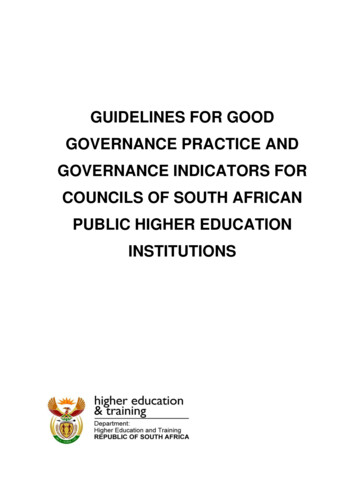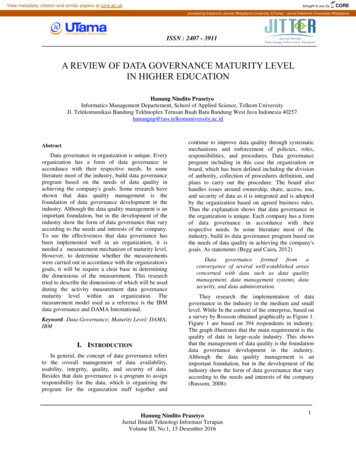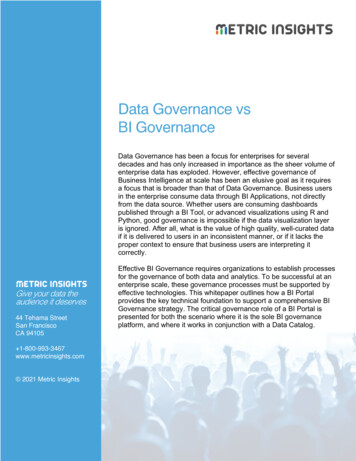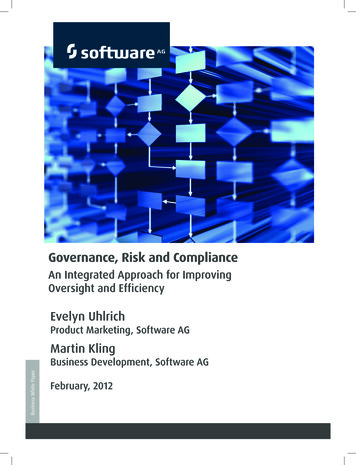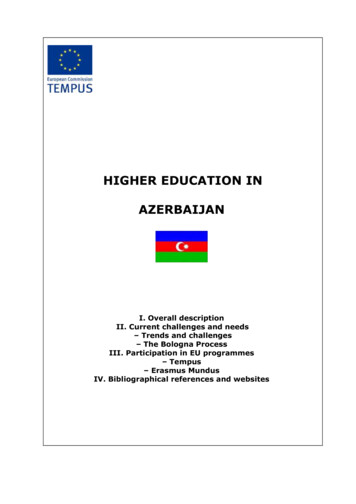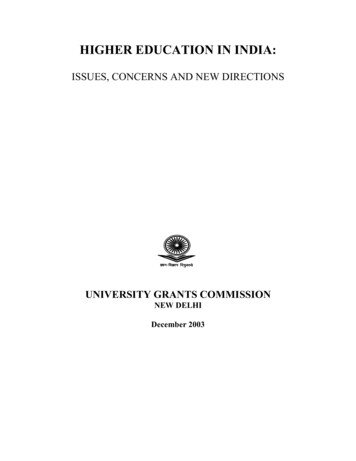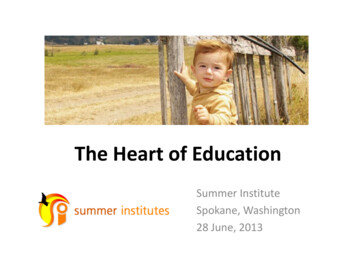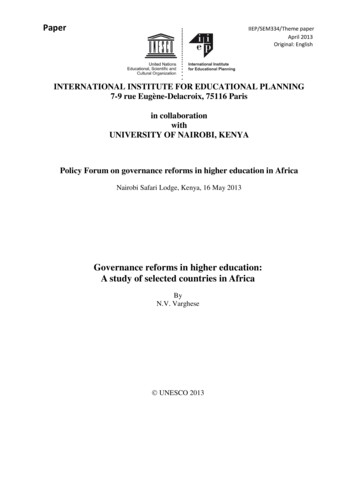
Transcription
PaperIIEP/SEM334/Theme paperApril 2013Original: EnglishINTERNATIONAL INSTITUTE FOR EDUCATIONAL PLANNING7-9 rue Eugène-Delacroix, 75116 Parisin collaborationwithUNIVERSITY OF NAIROBI, KENYAPolicy Forum on governance reforms in higher education in AfricaNairobi Safari Lodge, Kenya, 16 May 2013Governance reforms in higher education:A study of selected countries in AfricaByN.V. Varghese UNESCO 2013
IIEP/SEM334/Theme paperContents1. Introduction. 12. Global context of higher education expansion . 23. Higher education development in Africa . 54. Higher education reforms and expansion of higher education in Africa . 75. Nature of higher education reforms in the case study countries . 116. Did the reforms effect changes in governance and management of higher education? . 157. Did governance reforms improve higher education? . 188. Towards some generalizations . 20References . 23List of tablesTable 1: Gross enrolment ratios (GER) 1970-2010 . 10Table 2: Gross enrolment ratio for higher education in Sub-Saharan Africa 1970-2010 . 11Table 3: Characteristics of selected countries. 13
IIEP/SEM334/Theme paperGovernance reforms in higher education: A study of selected countries in Africa N.V. Varghese 1. IntroductionThe developments over the past decades indicate that globally the higher education sector hasmoved from a state of decline and disrepair to a state of revival and revitalization in thiscentury. The 1980s was a period of decline of higher education when student enrolmentdeclined even in the developed countries (Altbach, 1984) and the developing countries,especially in Africa, experienced a state of erosion of facilities and capacities (Kinyanjui,1994; Mamdani, 1993; Saint, 1992). The fiscal crisis and the resultant decline in state fundingwere considered to be a major cause of the decline.The higher education system in the developed countries was fast in responding to the declinethrough ‘cut back management’ policies and measures to withdraw public subsidies. Thedeveloping countries were slow and delayed in their response, although they too adoptedreforms to reduce cost (including staff reduction, a freeze on new appointments, and a freezeon increase in staff salary, etc.), share cost, generate income, and to improve efficiency of thesystem. Some of the reforms drove academic staff away from the university jobs to other morelucrative avenues of employment within the country and migration to other countries. Some ofthese policies also led to a deterioration of physical facilities and academic standards,contributing to a sharp decline in the quality of teaching and research.These trends are reversed in this century in the developing countries, notably in Africa.Between 2000 and 2010, the system not only expanded considerably adding more than 7.7million students annually, but the developing countries also accounted for a major share of thisincrease in enrolment; budgetary allocation to higher education increased; staff salariesimproved, as did teaching-learning conditions, leading to a revival of the sector. Today therates of growth of higher education are the highest in countries in Africa, although theirenrolment base still continues to be low. It is important to note that the expansion of the systemin this millennium was relying increasingly on non-state funding.The revival and revitalization of the sector reflecting increased resource availability, newprogrammes, and diversified provisions are results of the reforms implemented in the sector.These reforms helped to reduce reliance on state funding and state control on institutionalgovernance and management, made institutions autonomous and self-reliant, and madehouseholds willing investors in higher education. These changes altered the way the highereducation system is governed and institutions are managed. This paper attempts to elaborate onthese changes in Africa based on the case studies carried out in some of the countries in theregion. Theme paper for the Policy Forum on Design and management of higher education in Africa: The role ofsteering policies and governance reforms in the management of higher education. The opinions and viewsexpressed in this paper are of the authors and hence should not necessarily be attributed to the institution wherethey are employed. N.V. Varghese, Head, Governance and Management in Education, IIEP/UNESCO, Paris, France,nv.varghese@iiep.unesco.org1
IIEP/SEM334/Theme paperThe plan of the paper is as follows: The next section discusses the global changes in highereducation and their effects on the expansion of higher education. Section 3 deals withdevelopment of higher education in Africa focusing more on the initial concerns andorientations, followed by a discussion on reforms and expansion of higher education in Africain Section 4. Section 5 focusses on the reform measures studied in the case study countriesand their effects in Section 6. Section 7 tries to analyze whether or not these reformsimproved the sector as a whole, and the final section attempts to conclude by generalizingsome trends seen in the case study countries.2. Global context of higher education expansionThe higher education sector has experienced a surge in growth in this century, and itsexpansion has become a global phenomenon encompassing countries in all regions. Anincreasing recognition of its economic and social value, no doubt, has contributed to increasedpropensity to invest in higher education by the public authorities, private corporations andhouseholds.In terms of its economic value, higher education plays an important role in the production anddistribution of national income. While the knowledge produced and skills imparted by thesector contribute to faster growth in national income, an expansion of the system contributesto more equal sharing of the national income. With expansion of the knowledge economy, theknowledge produced by the system and the skills possessed by its graduates are becomingdeciding factors in promoting economic progress and social welfare.Research evidence indicates that knowledge has been the single-most important engine ofgrowth and the driving force of economic performance in OECD countries over the pastdecades (OECD, 2000; UIS/OECD, 2003). Therefore, it is recognized now, more than everbefore, that the universities and research organizations influence the economiccompetitiveness of individual economies in the context of globalization. The countries whichhave an expanded system of higher education with higher levels of investment in research anddevelopment (R&D) activities have higher potential to grow faster in a globalized knowledgeeconomy.The use of knowledge, even when it is produced outside, depends on the human capacity toaccess, assimilate and absorb it. Education no doubt enhances the human capacity and choiceto improve accessibility. A broad-based higher education provides “the necessary foundationfor a productive, prosperous and resilient country (Group of Eight, 2013, p.7). That is one ofthe reasons why countries with universal higher education systems are economically morecompetitive than others.The other aspect, namely the role of higher education in income distribution, is also equallyimportant. Higher education contributes to improved individual income through differentchannels. First, the labour force participation rates of the higher educated are consistentlyhigher than those who are less educated. In the case of women, participation rates varysignificantly between those who are university-level educated and those who are school-leveleducated (UIS-OECD, 2003). The labor force participation rate of women increases withevery level of education, and it improves significantly with the tertiary level of education andthus comes closer to their male counterparts. From this point of view, women gain more thanmen by obtaining higher level qualifications.2
IIEP/SEM334/Theme paperSecond, higher educated persons get into sectors and jobs which are higher paying, leading toan enhanced average income of the educated in general. Third, the skill premium enjoys awage premium in the labor market, especially in the context of globalization. And in therecent past, the earning advantages associated with those in elite occupations increasedconsiderably. All these factors show that it is beneficial to pursue higher education since itincreases employability and the chances of being employed in the high-wage sector. Fourth,the unemployment rate increases with levels of education in most cases up to the secondaryeducation level and declines thereafter. Therefore, enrolling in tertiary education institutionsand graduating from them reduce the chances of being unemployed.Recent estimates of rates of returns to investment in education show that returns to highereducation are not only on the increase but also surpass that of the other levels of education.This is contrary to the evidence generated in the 1960s and 1970s (World Bank, 2002) wherereturns to primary education were higher than those at other levels. The earning advantage ofhigher education graduates (men) over secondary school graduates varies from 82 per cent inIndonesia to almost 300 per cent in Paraguay. For women, the corresponding variations arefrom 55 per cent in Indonesia to 179 per cent in Brazil (UIS-OECD, 2003).In a sense, at the individual level higher education is one of the best choices for increasedlifetime earnings and the best unemployment insurance. For nations’ investments in highereducation and knowledge production are rewarding and a growth promoting factor especiallyin the knowledge economies. However, knowledge gap continues to be “one of the mostimportant social and economic divides in modern democratic societies” (Bergan, 2005: p.15)and therefore bridging this gap becomes an essential step to promote more equal growthamong nations and within countries.Globalization of production demands standardized skills and training to meet global standardsirrespective of location of production. Many of these skills and competencies are developedmostly at the post-secondary level of education. In other words, the knowledge-drivenproduction of goods and services increases the demand for higher educated manpower. It canbe seen that the proportion of employees with higher levels of education are increasing in thedeveloped countries which are more knowledge-based than others (World Bank, 2002).Apart from the economic arguments, there are pressures to expand higher education stemmingfrom the success of EFA programmes of the past decades where by the number of secondaryschool graduates seeking higher education has surged. The other side of the story is that withthe expansion of education at the school level the demand for the number of universitygraduates to be employed as teachers increased. Therefore, expansion of higher education ispropelled by larger pool of school graduates eligible for admission in higher educationinstitutions and compulsions of expanding lower levels of education.From the social point of view, many of the social indicators of development improve once thelevel of education increases. In any case, one of the arguments for an expanded highereducation is that less-educated people are better off in a well-educated society than in asociety with a mediocre level of education (Weber, 2005). This in a sense justifies theexpansion of higher education, even when its effects are unequally distributed.3
IIEP/SEM334/Theme paperWho should finance the expansion?When higher education was a small sector catering to the elites, it was highly subsidized andwas funded by the state in most countries. When expansion of the sector became rapid,attracting even the first generation learners to higher education, the debate on financing ofhigher education even became very lively. At one end are those who consider highereducation to be a public good to be funded entirely by the state, and at the other end are thosewho argue that it brings huge individual dividends and hence should be financed privately andtraded publicly – higher education should be treated as a commodity to be traded in themarket just like any other commodity. This idea lies at the heart of bringing education underthe General Agreement of Trade in Services (GATS) (Knight, 2002; AAU, 2004; Tilak,2011).Many economists have argued that knowledge is a public good (Samuelson, 1954) and someconsider it to be a global public good (Stiglitz, 1999) implying the non-rivalrous consumptionand non-excludability in its distribution. The communique adopted by the ministers on theBologna process in the Prague Higher Education Summit stated that “higher education shouldbe considered a public good and is and will remain a public responsibility” (Bergan,2005:p.13). One of the major policy implications of categorizing higher education as a public goodis that, in the absence of state investment, it will be under-produced and under-supplied.Even when doubts are cast on the public goods characteristics of higher education, no onedoubts the externalities due to higher education. The external benefits of higher educationimply that collective returns to investments in higher education are greater than the sum ofindividual returns. Markets may not take into account these external benefits and will underinvest in higher education (Jonathan, 2001; Tilak, 2008). Since higher education producesexternal benefits, the state has to intervene to avoid under-provision. It is this understandingthat promoted state funding in higher education.The state played a dominant role in development during the post-World War II reconstructionphase in Europe and nation-building phase following national independence in the developingcountries. Most countries invested in higher education during this phase, recognizing theimportance of qualified and trained manpower in nation building. There was, in a sense, a‘state monopoly on tertiary education’ (World Bank, 2002: p.69) and public universitiesbecame the dominant feature of the development of higher education. This tradition continuesand public universities continue to dominate in all regions except Latin America and EastAsia.The state-led model of development came under attack in the 1980s. The neo-liberal thinking,structural adjustment programmes of the 1980s, and the political changes in Eastern Europequestioned the role of the state in development and the rationale for continued state investmentin higher education. The argument was for a reduced public investment in education in general,and a diversion of public investment from higher to primary education in developing countriesin particular (World Bank, 1986; Banya and Elu, 2001).The market-friendly reforms and globalization processes in recent decades gave strength tothe argument for expanding higher education without placing additional burden on the publicexchequer. Households and private sources are increasingly supporting the increasing socialdemand for higher education. Consequently, developed and developing countries reduced, if4
IIEP/SEM334/Theme papernot withdrew, subsidies to higher education and introduced cost-recovery measures, costsharing strategies, and income-generating activities (Sanyal,1995; Ishengoma, 2004) in publichigher education institutions to expand. These entrepreneurial universities (Clark, 1998)helped expand enrolment without burdening public exchequers.In terms of changes in the governance of public institutions, MOEs reduced their powersmostly to overall policy, strategic planning, coordination, and fund negotiations with otherministries (of finance) and foreign agencies; many governments transferred theresponsibilities of higher education and its governance to the provincial level, delegatedpowers to buffer organizations, and granted autonomy to institutions (Fielden, 2008).This period also experienced the emergence of the private sector in higher education,especially in many of the developing countries, which did not have a tradition of any privatehigher education institutions. Provision, production and financing higher education can beentirely by the state, by market or by a combination of the two. As discussed above, the state(public universities) is losing its monopoly in provision and production and a totally marketrelied process (private for-profit institutions) does not exist anywhere as the dominantprovider of higher education. What is increasingly becoming a common practice in provisionof higher education is that public funds are allocated more on the basis of market principles,and markets in higher education very often are not confined to for-profit entities (Weber,2005).The enrolment in higher education globally increased from 100 to 177.7 million between2000 and 2010 (UIS, 2012) reflecting an average annual increase in enrolment of more than7.7 million students in the previous decade. The world average in GER in 2010 is 29 per cent.However, the GER not only varies across regions but also widened over a period of time. Forexample, the GER varies from seven per cent in sub-Saharan Africa to 76 per cent in NorthAmerica and Western Europe. The GER more than doubled between 1991 and 2010 in theArab region (from 11 to 24 per cent), more than quadrupled in East Asia and the Pacific (fromseven to 29 per cent), increased to almost three times (from six to 17 per cent) in South andWest Asia, and more than doubled (from 17 to 41 per cent) in Latin America. What isimportant to notice is that this fast expansion of the sector is very often taking place with nonstate funding.3. Higher education development in AfricaDevelopments in the higher education sector in Africa also followed some of the global trendsdiscussed above. At the time of independence, most of the African countries heavily relied onexternal experts to manage the economy. The idea of ‘development universities’ (Cloete et.al., 2011) underlined the role of universities in development to meet the human resourceneeds of the economy. During and after the national liberation struggles, there was a seriouseffort to Africanize the administration and decision making. “The first step in Africanindependence was to put Africans at the top of the government . Africanization haseverywhere gone more quickly than the colonials anticipated There has consequently beena strongly expansionist view of higher education” (Sutton, 1971).One of the important roles played by the higher education sector in the post-independenceperiod in many countries is that of the indigenization (nationalization) of development. Thisindigenization process was necessary at least in two aspects: a) indigenization development;5
IIEP/SEM334/Theme paperand b) indigenization of education (Atal, 1995). The former implied the replacement ofexpatriates in administration and decision-making positions by the nationals. However, manynewly independent countries did not have universities to provide training to high-levelprofessional staff needed to replace the expatriates and hence these countries relied onsending persons abroad for training (Kidd, 1991). The establishment of national universitiesin many instances helped train nationals and indigenize development.The indigenization of educational development implied indigenizing teaching staff,curriculum, and language at the different levels of education. The priority for the nationalgovernments was to train nationals to teach in schools, especially primary schools. Althoughthis sector too was depended on expatriates, the domestic higher education institutions over aperiod of time succeeded in producing trained nationals and helped replacing expatriates inthe teaching professions. At present, the teaching staff at all levels of education in most of thecountries in Africa is dominated by nationals.The state and public sector institutions were central to the development strategy of the newlyindependent countries in Africa. This model was replicated in education. Higher educationwas provided through public universities. The decades of 1960s and 1970s saw theestablishment of new universities in African countries. Further, public universities in thesecountries also “symbolized national pride and self-respect” (Coleman and Court, 1993) andself reliance. It can be seen that, under this frame of analysis, the expansion of highereducation served both political and economic aspirations of the newly independentgovernments. Hence, the governments were willing to allocate resources and invest in highereducation.The post-independence period saw a positive political attitude and a favorable resourceallocation policy towards higher education. It seems that the higher education sector was abeneficiary of the compulsions of replacing the expatriates who occupied more than60 per cent of the jobs requiring university-level qualification. In the decade followingindependence, the allocations to higher education averaged around 19 per cent of theeducation budget even when enrolment in higher education was less than one per cent of therelevant age-group making unit costs very high (Hinchliffe, 1987). During this period highereducation remained an elite sector with limited access but with liberal public funding support.African universities, like in other regions, were shaped after institutions of higher educationoperating in the respective colonial powers. Universities in Francophone Africa were shapedafter French universities and those in Anglophone countries were shaped after British andAmerican universities. The universities had limited access; a foreign language was themedium of instruction; and these institutions enjoyed limited autonomy (Teferra and Altbach,2003). In many instances, political leaders (Presidents and Prime Ministers) becameuniversity chancellors and patrons, thus enjoying considerable power and influential authorityover university affairs and limiting the autonomy of these institutions.International agencies also helped shape the development of higher education in Africa.UNESCO sponsored the first Africa-wide conference on higher education in Tananarive in1962 which paved the way for the creation of the Association of African Universities. Theheads of universities who participated in the Tananarive conference met in Khartoum to formAAU, which was formally inaugurated in Rabat, Morocco, in 1967. AAU organized regular6
IIEP/SEM334/Theme papermeetings to provide the vision and framework for the development of higher education inAfrica.During this period the major sources of funding came from the government and in that sensethis was a period of expansion of higher education through highly subsidized publicinstitutions. The other source of financing higher education was external funding. The WorldBank remained the single largest source of external funding for higher education in Africa(Habte, 1989). Many private foundations made substantial contributions to developinginstitutional capacity to carry out research and training in Africa. The Rockefeller Foundationconcentrated its efforts in certain selected universities and also provided fellowships andgrants for study abroad programmes, especially for the Master’s and doctoral level, appointedvisiting staff, and provided research grants to promote local research (World Bank, 1988).The Carnegie Corporation, the Kellogg Foundation, and the Ford Foundation, etc., were othernotable private agencies.These trends in external funding continued even in the new millennium. In 2000, aconsortium of four US philanthropic foundations began an initial five-year programme toassist selected universities in some of the African countries. Higher education institutions inAfrica also received support from governments and agencies from many European countriessuch as Belgium, France, Germany, the Netherlands, Norway, Sweden, the UK, etc. Recenttrends in external funding of higher education show that a major share of higher education aidis indirect and its share increased from 62 per cent in 2002 to around 90 per cent in 2006(Varghese, 2010).This state-funded, heavily subsidized model of higher education did not last long. In the1980s, the share of higher education in state funding declined, as did external funding ofhigher education. As a result, many public universities have fallen into a ‘severe state ofdisrepair’. Deterioration in physical facilities and academic provisions combined with facultyflight due to low pay scales and non-payment of salaries led to a sharp decline in the qualityof higher education imparted in the universities (Mamdani, 1993; Mwiria, 1992; Teferra,1997; Adeyemi, 2000). The net migration from SSA doubled from 0.57 million in 1995 to1.07 million in 2005 and an estimated one third of this number were university graduates(World Bank, 2009).These developments, no doubt, have contributed to a deterioration of teaching standards, adepletion of research capacities, and an erosion of national analytical capacities to providepolicy support (Saint, 1992; Otieno, 2003). The major question in the 1990s was on designingsurvival strategies to reconstruct and revive higher education in the region (World Bank,1988; Eisemon, 1989). The educational reforms in Africa in the 1990s were centred on theissue of financing alternatives to promote an expanding system of higher education andmanaging the universities more efficiently and effectively (Sanyal, 1995).4. Higher education reforms and expansion of higher education in AfricaThe revival of higher education needed reforms to mobilize resources and the restructuring ofstudy programmes, governance and management to better align with markets. The economicreforms of the 1990s clearly indicated a move away from the state to market. Market-friendlyreforms became common in economic sectors and their influence was also reflected ineducation, especially higher education. However, the pressure to reform higher education was7
IIEP/SEM334/Theme paperworldwide as the knowledge-based economy becomes the motor of economic growth andcompetitiveness (Fielden, 2008).The global environment of positive orientation towards market-friendly reforms in highereducation no doubt encouraged and promoted similar reforms in Africa. However, thecountries in Africa had their own compulsions. First, the political changes and a return todemocracy in several countries of Africa in the 1990s were important influencing factors todemocratize higher education and improve access to it (Moja, 2004; Cloete and Bunting,2002). Second, the fiscal crisis and inability of the state to fund an expanding system ofhigher education forced countries to evolve alternative strategies for the financing of highereducation (Kinyanjui, 1994; Court, 1999; Chuta, 1998). Positive economic growthaccompanied by improved household income and better employment prospects increased thecapacity and willingness of households to invest in quality higher education for their wardsand it provided a fertile ground for market operations in higher education.The pressure to reform came from three sets of actors – the state and the corporate sector forimproving economic growth and competitiveness, the employers looking for relevant skills,and the households for their willingness to pay. The reforms are also an effort to satisfy theseactors and respond to their concerns. There are core concerns, common across reforms inseveral countries, although their relative importance varies depending on the level ofdevelopment of the country (Varghese, 2012). Most reforms express: a) a concern forknowledge production and use of knowledge in production. The pre-occupation in manycountries with university ranking and the establishment of world class universities (Salmi,2009) stems from this premise; b) a concern for realigning higher education to theemployment market (Al-Samarrai, 2003; UNESCO, 2012); and c) a concern for expandinghigher education.Although, all three concerns were relevant for higher education reforms in Africa, theimmediate concern was to expand the system since the region not only had the lowest GERsbut also that enrolments were stagnating, if not declining, in many instances. Certain aspectsof globalization, namely the encouraging of market principles in all sectors includingeducation, helped devising strategies for the expansion of the system relying on non-stateresources. It is argued that the impact of globalization on higher education in Africa isreflected in terms of six Cs: Corporatization of management; collectivization of access;commercialization of learning; commodification of knowledge; computerization of education,and; connectivity of institutions (Zelena, 2004).It can be argued that several reforms in higher education in Africa may be stemming morefrom the compulsions of the state to expand higher education and the fiscal constraints of thestate to finance the expansion. The market-friendly reforms were an integral part of thispackage of reforms in the context of the globalization process. From this pe
INTERNATIONAL INSTITUTE FOR EDUCATIONAL PLANNING . 7-9 rue Eugène -Delacroix, 75116 Paris . UNIVERSITY OF NAIROBI, KENYA . Policy Forum on governance reforms in higher education in Africa . Nairobi Safari Lodge, Kenya, 16 May 2013 . Governance reforms in higher education: A study of selected countries in Africa. By . N.V. Varghese UNESCO .
